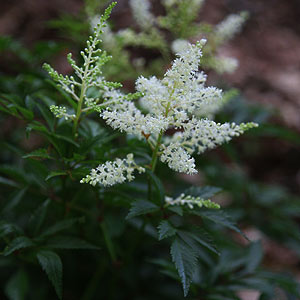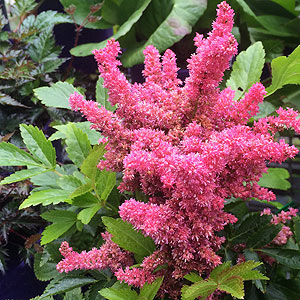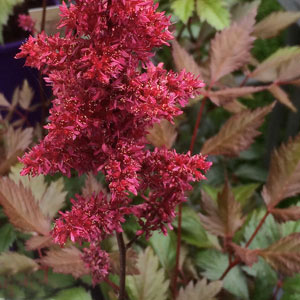
Long flowering Astilbe are a shade loving perennial that also have attractive ferny foliage. Easy care and an excellent plant for a moist woodland position.
They can also be grown in containers where the fine foliage is attractive from spring through to fall.
They are not really an early spring plant, more of a late spring to early summer, with flowers in early summer to mid summer. Some species are quick spreading others are very slow.
Astilbe flowers range from white through to lilac, red and pink. These really are a shade loving plant and given the right growing conditions require little care. Astilbe are also referred to as ‘Feather Flower’, False Goats Beard’ and ‘False Spirea’.
Most species prefer a moist part shaded position. A humus rich well dug soil is best. The feathery plumes of the Astilbe Flower are long lasting if planted in part shade, and the foliage will not burn as it will in full sun.
Where are they grown
Generally USDA Zones 3 – 8. They do not like long dry periods in summer, and require protection from freezes in winter.
Astilbe are popular in Minnesota, Vermont, Maine, Wisconsin, Connecticut, New Hampshire, Iowa, Michigan, Illinois, Nebraska, Pennsylvania, Maryland, Washington and Oregon.
The foliage of astilbe is feathery and attractive and the flower will attract butterflies. Plants can be divided in fall or spring.
Care

Although put forward as a shade loving moisture loving perennial, this is not exactly true.
It fact with to much shade and to much moisture you will have problems. Astilbe ‘Fireberry’ with its berry red to pink flowers, pictured right is no exception.
The best time to plant Astilbe is in early spring, as soon as the weather warms a little.
Look for a position in dappled shade, or light morning sun and part shade.
Ensure that the soil is moisture retentive however not boggy and waterlogged.
Dig in well rotted compost and some leaf mold if you have it, in poor draining areas amend the soil by digging in some perlite to assist with he drainage.
Water in plants with a liquid seaweed fertilizer.
The further north you live the more sun these wonderful plants can take. They are regarded as a perennial suited through to USDA Zone 3.
Problems
- Astilbe not flowering – Generally plants are not receiving enough light.
- Foliage browns in summer – Astilbes do not like hot direct sun.
Pruning

You can give plants a quick pruning, usually at the end of the season when the foliage is dying back, however we tend to leave them to their own devices. The foliage and stems are not woody and quickly disappear.
You can also deadhead if you like to keep plants tidy. Although again this serves no real purpose as Astilbe tend not to respond with a second flush of flowers. We tend to think that the spent flower heads on the taller varieties look great through to early winter, so we leave them.
So prune to tidy up if you wish. You can also snip off a few flowers, they look great in a vase, especially the taller varieties.
Astilbe ‘Fanal’
Varieties
Although the cultivars are the most colorful and usually with the best flowers forms. Astilbe ‘Fanal’ pictured right is an example, deep red flowers, bronze to green foliage and the flower held upright to around 18 inches, it is sometimes best to look at the botanical background.
If you are looking for the most ‘sun tolerant’ varieties then Astilbe chinensis are the best, they cope well with more sun and are also better with less water, however they still do not like to dry out.
- Astilbe chinensis are mostly tall growing and can reach 4ft, mostly smaller.
- Astilbe chinensis var. ‘pumila’ is a low growing species to around 1ft in height, that is faster spreading than other species. Pink to mauve flowers.
- Astilbe chinensis var. taquetii, taller growing to 4 ft, pink to mauve flowers.
- Astilbe chinensis var. davidii most likely the tallest of all, reaching 5 – 6 ft in ideal conditions, flowers tend toward a pale mauve,
- Astilbe thunbergii ‘Prof. van der Wielen’ has white flowers and will reach around 2ft in height
- Astilbe thunbergii ‘Straussenfeder’ very attractive pink flower plumes, one of the best taller growing hybrids.
- Astilbe x arendsii are a group of hybrids bred in Germany, they include many colorful cultivars including the well known Astilbe ‘Fanal’, ‘Showstar’, ‘Fiery Red’ and the lovely pink flowering ‘Sister Theresa’
- Astilbe ‘Deutschland’ are another group of hybrids from Germany.
Propagation
Propagation is easiest by division of larger established clumps. The best time to divide clumps is in spring, although you can divide in fall if you must.
- Dig the clump with a garden fork.
- Divide with a sharp garden knife or spade
- Replant and water in with a liquid seaweed fertilizer, this help reestablish root systems.
Where to Buy
You can find Astilbe for sale at the following nurseries
PINE KNOT FARMS
681 Rockchurch Road, Clarksville Virginia 23927 USA
434-252-1990 phone 434-252-0768 fax
Mail order, retail and wholesale of our specialty, is hellebores. Open on site on Fridays and Saturdays in spring and fall where we offer a full range of herbaceous material.
DIGGING DOG NURSERY
PO Box 471 Albion CA 95410
phone (707) 937-1130
A spectacular selection of hard to find perennials, ornamental grasses, shrubs, trees and vines for your garden.
BLUESTONE PERENNIALS
Offering a wide selection of bulbs, perennials, grasses, herbs trees and shrubs. Includes: achillea anthea, achillea fiesta, achillea froelich, achillea jungfrau, achillea moonshine, achillea terra cotta, achillea paprika.
CLASSY GROUNDCOVERS
PO Box 2556 city: Blairsville GA 30514
BIG DIPPER FARM
26130 SE Green Valley Rd Black Diamond, WA 98010
Phone 360.886.8133

